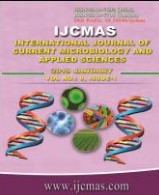


 National Academy of Agricultural Sciences (NAAS)
National Academy of Agricultural Sciences (NAAS)

|
PRINT ISSN : 2319-7692
Online ISSN : 2319-7706 Issues : 12 per year Publisher : Excellent Publishers Email : editorijcmas@gmail.com / submit@ijcmas.com Editor-in-chief: Dr.M.Prakash Index Copernicus ICV 2018: 95.39 NAAS RATING 2020: 5.38 |
A field experiment was conducted during 2017-2018 at N. E. Borlaug Crop Research Centre of Govind Ballabh Pant University of Agriculture and Technology, Pantnagar, to study the integrated weed control option for dry Direct seeded Rice under irrigated ecosystem. Study reveals that stale seed bed with shallow tillage with pre-emergence application of pendimethalin followed by 1 mechanical weeding (MW) with conoweeder at 25 DAS along with 1HW at 45 DAS, Mulch followed by penoxsulam (PoE) followed by 1HW at 45 DAS, Sesbania line sowing with pre-emergence application of pendimethalin followed by 1 MW followed by 1HW at 45 DAS and Stale seed bed with shallow tillage followed by Sesbania line sowing supplemented with pre-emergence application of pendimethalin followed by brown manuring with 2,4-D followed by 1 HW at 45 DAS resulted lowed weed density (gassy, BLWs and sedges), weed biomass accumulation and higher WCE (%) i.e. 90.2, 89.7, 89.3 and 88.1 respectively which were similar to recommended practice under 25 cm row to row spacing i.e. pre-emergence application of pendimethalin followed by post emergence application of penoxsulam supplemented with 1 HW at 45 DAS. Higher benefit cost ratio was recorded under stale seed bed with shallow tillage with pre-emergence application of pendimethalin followed by 1 mechanical weeding (MW) with conoweeder at 25 DAS along with 1HW at 45 DAS, mulch followed by penoxsulam (PoE) followed by 1HW at 45 DAS and Sesbania line sowing with pre-emergence application of pendimethalin followed by 1 MW followed by 1HW at 45 DAS. From the study it can be concluded that above three integrated practices were same effective as recommended practice for controlling weed with higher return.
 |
 |
 |
 |
 |